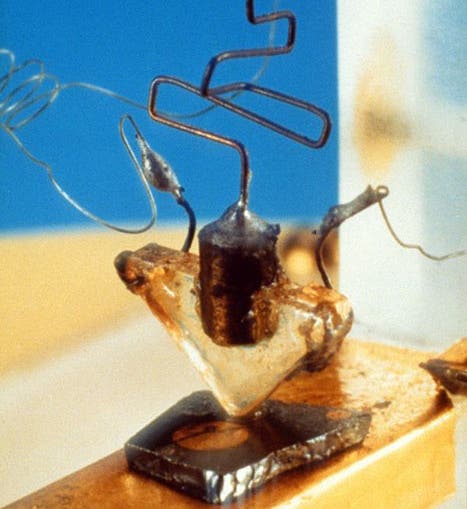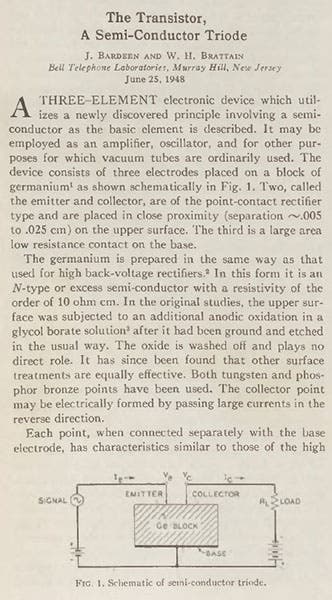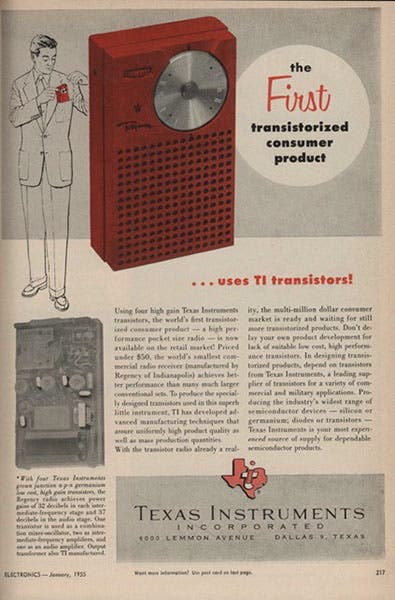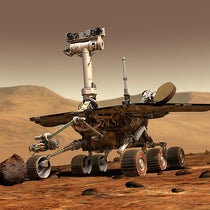Scientist of the Day - The Transistor
Seventy-five years ago, on December 16, 1947, John Bardeen and Walter Brattain successfully tested the world’s first transistor in Murray Hill, New Jersey. The two physicists were members of a Bell Labs research group seeking a new means of amplifying electrical signals. During the first half of the 20th century, electrical engineers had relied on vacuum tubes to accomplish that task, but those devices were bulky, fragile, and consumed a great deal of power. Bardeen and Brattain’s supervisor, William Shockley, theorized that it might be possible to develop an improved amplifier by capitalizing upon the previously unexplored electrical properties of semiconductors.
Shockley’s research team focused their attention on the surface of materials like germanium, where a layer of electrons prevented external electric fields from modulating current passing through the interior. Beginning in mid-November 1947, Bardeen and Brattain conducted a series of experiments that eventually allowed them to circumvent this barrier and create a solid-state amplifier. The culmination of this “magic month” of research came on Tuesday, December 16, when Brattain suspended a small plastic wedge above a piece of germanium. He wrapped a thin ribbon of gold foil around the wedge and used a razor to slice it in half at the vertex. He then carefully maneuvered the wedge so that the resulting electrical contacts touched the surface of the germanium and connected the entire setup to a power supply. Incredibly, this makeshift apparatus was able to boost both the power and voltage of an incoming signal without a vacuum tube (first image).
After sharing their findings with Shockley, Bardeen and Brattain scheduled a demonstration for Bell Labs’ leadership team on December 23, 1947. After the holidays, they started working on a patent application, while management began brainstorming a name for the new amplifier. Ralph Bown, Bell Labs’ vice president for research, organized a committee to resolve the latter question. In May 1948, this group circulated a memo asking key executives and members of the technical staff to choose between half a dozen possible options, including “Semiconductor Triode” and “Iotatron.” When the ballots were counted, the winner was transistor, which the memo described as “an abbreviated combination of the words ‘transconductance’ or ‘transfer’ and ‘varistor.’”
Bown would later take center stage at the June 30, 1948 press conference that introduced the public to Bardeen and Brattain’s invention, which by then had been redesigned as a metal cylinder smaller than a paperclip, which contained two fine wires touching a pinhead-sized sliver of germanium. Standing next to a giant cutaway model of the transistor at Bell Labs’ New York City headquarters, he explained that it could “do just about everything a vacuum tube can do, and some unique things which a vacuum tube cannot do” (second image). He then invited reporters to listen to his voice being amplified with transistors through headphones attached to their seats. Other demonstrations featured an oscillator circuit that did not require any time to warm up (a common issue when dealing with vacuum tubes) and an off-the-shelf radio receiver whose tubes had been replaced with transistors (third image).
Members of Bell Labs’ technical staff were convinced that the transistor was a game-changing innovation, but the same could not be said of the popular press. In a move that would subsequently be deemed short-sighted, the July 1, 1948 edition of the New York Times limited coverage of the press conference to a handful of paragraphs in a column on page 46 entitled “The News of Radio.” The scientific community responded more enthusiastically to Bardeen and Brattain’s first article on the transistor in the July 15, 1948 issue of Physical Review (fourth image).Not to be outdone, the editors of Electronics, a leading trade journal, placed a photograph of Bardeen, Brattain, and Shockley inspecting a “crystal triode” on the front of their September 1948 issue. (Regrettably, the Linda Hall Library’s copy of that publication had its cover removed when it was sent to the bindery.)
As much as Bell Labs appreciated this publicity, it was clear that there was still much to learn about the theoretical principles underlying the transistor’s operation and how easily it could be mass produced. One person who was interested in both questions was William Shockley. In 1950, he published an influential textbook summarizing the latest developments in semiconductor electronics. While working on that manuscript, he also oversaw the development of an entirely new type of transistor, consisting of three layers of semiconductors with varying electrical properties that were placed in direct contact with one another. In addition to eliminating the need to fabricate delicate electrodes on the surface of the semiconductor, Shockley’s sandwich-shaped “junction” transistor offered greater power efficiency and reliability compared to Bardeen and Brattain’s “point-contact” design. For these reasons, the junction transistor eventually became the industry standard.
Before that could happen, however, other companies would need to embrace transistor technology. In response to growing demand from rival electronics firms and the U.S. military, Western Electric (AT&T’s manufacturing subsidiary) began licensing the rights to produce transistors in 1951. That year, Bell Labs started organizing symposia where licensees could learn about the latest semiconductor production methods. The proceedings from the second of these meetings, held in April 1952, were initially classified due to national security concerns but were subsequently issued as a two-volume set (Transistor Technology) that was nicknamed “Mother Bell’s Cookbook” by industry professionals (fifth image).
Thanks to these outreach efforts, transistors gradually made their way into consumer products, beginning with the Sonotone 1010 hearing aid in 1952. Two years later, Texas Instruments (TI) and the Regency Division of Industrial Development Engineering Associates (IDEA, an Indianapolis-based electronics company) released the Regency TR-1, the first commercially available transistor radio (sixth image). The TR-1 was expensive ($49.95), and Consumer Reports noted that its ability to pick up signals and overall sound quality paled in comparison to other portable models. Despite these shortcomings, Americans purchased over 100,000 TR-1 units, confirming the popularity of the lightweight, pocket-sized, electronic devices that could now be produced using transistors.
The success of the TR-1 revealed how much the transistor was beginning to alter the landscape of the American electronics industry. Established east coast corporations like AT&T, IBM, and RCA now faced competition from newcomers like TI, which began selling the first silicon transistors in 1954. These devices were more difficult to manufacture than their germanium predecessors, but their superior performance inspired a growing number of people to explore the technological possibilities of silicon. Foremost among them was William Shockley, who left Bell Labs in 1955 to establish the first of many semiconductor firms in the region that would become known as Silicon Valley. The following year, he traveled to Stockholm along with Bardeen and Brattain to accept the Nobel Prize in Physics “for their researches on semiconductors and their discovery of the transistor effect.”
Over the coming decades, engineers continued to design smaller, faster transistors and new products capitalizing on their ability to detect and amplify electrical signals. The growing complexity of these systems led electrical engineers Jack Kilby (TI) and Robert Noyce (Fairchild Semiconductor) to develop the first integrated circuits, featuring multiple transistors, capacitors, or resistors on a single semiconductor substrate. Subsequent improvements in fabrication techniques led to an exponential growth in the number of transistors that could fit on a silicon wafer (famously documented in 1965 by Noyce’s colleague, Gordon Moore) and the creation of the modern microchip. Today, billions of microscopic transistors can be found in each of our laptops, cell phones, televisions, and video game systems. Together they comprise the invisible foundation of our digital world, and every single one can trace its origins to an experiment conducted seventy-five years ago today in an unassuming laboratory in New Jersey.
Benjamin Gross, Vice President for Research and Scholarship, Linda Hall Library. Comments or corrections are welcome; please direct to grossb@lindahall.org.






![Verso of title page and half-title (p. [iv-v]) in Volume 1 of the proceedings from Western Electric’s April 1952 Transistor Technology Symposium. This copy contains a stamp confirming that its classification status changed from “Restricted” to “Unclassified” in July 1953. (Linda Hall Library)](https://assets-us-01.kc-usercontent.com:443/9dd25524-761a-000d-d79f-86a5086d4774/7b68e1eb-96f3-4e46-b934-930d7ff588e0/transistor5.jpg?w=797&h=600&auto=format&q=75&fit=crop)





